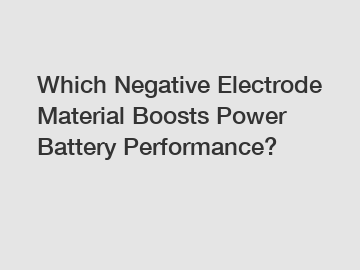Which Negative Electrode Material Boosts Power Battery Performance?
In today's world, power battery technology is crucial for various applications, ranging from electric vehicles to renewable energy storage solutions. While advancements in battery technology have improved energy density and overall performance, the choice of negative electrode material plays a pivotal role in achieving optimal results. In this article, we will explore the various negative electrode materials and determine which one emerges as the best contender for bolstering power battery performance.
1. Graphite:
When it comes to negative electrode materials, graphite has enjoyed a long-standing reputation in the battery industry. Graphite has several advantageous properties, such as high energy density, good stability, and chemical resistance. These characteristics have made it the material of choice in many commercial lithium-ion batteries. However, in terms of power battery performance, graphite is known to have limitations.

Graphite electrodes exhibit a slower reaction kinetics, resulting in a lower power density. In applications that require rapid charging and discharging, such as electric vehicles, the sluggish performance of graphite can hinder overall acceleration and regeneration efficiency. Consequently, researchers have looked for alternatives that can address these limitations while maintaining other desirable properties.
2. Silicon:
Silicon has emerged as a promising alternative to graphite due to its superior theoretical capacity. With ten times the lithium-ion storage capacity of graphite, silicon-based electrodes offer significant potential for boosting power battery performance. Moreover, silicon is abundantly available and relatively cost-effective, making it an attractive option for large-scale applications.
However, the drawback with silicon lies in its poor cycling stability. During the charge and discharge cycles, silicon electrodes tend to suffer from significant volume expansion and contraction, which leads to material degradation and reduced lifespan. Researchers are actively working on improving silicon's cycling stability through innovative nanostructuring techniques and other methods to unlock its full potential.
3. Lithium Titanate:
Lithium titanate (Li4Ti5O12) is a lesser-known alternative that has gained attention recently due to its exceptional power performance. Lithium titanate exhibits excellent rate capability, meaning it can charge and discharge rapidly without significant losses in capacity. This property makes it ideal for applications demanding high-power outputs, such as electric buses or grid energy storage systems.
Additionally, lithium titanate exhibits excellent cycling stability, retaining a high capacity even after thousands of charge and discharge cycles. The material's stable potential and negligible volume change during cycling contribute to its extended lifespan, ensuring long-term reliability. While lithium titanate may have a slightly lower energy density than graphite and silicon, its remarkable power performance compensates for this trade-off.
Conclusion:
As the demand for high-performance power batteries continues to grow, finding the ideal negative electrode material becomes paramount. Despite graphite's long-standing dominance, its slower reaction kinetics limits its suitability for power-intensive applications. Silicon, on the other hand, showcases immense theoretical capacity but struggles with cycling stability.
Lithium titanate, albeit relatively lesser-known, emerges as a strong contender for boosting power battery performance. Its exceptional rate capability and cycling stability make it a promising choice for empowering applications that require rapid charging and discharging. However, ongoing research and development efforts are vital to further optimize lithium titanate and address any remaining challenges.
New advancements and breakthroughs in material science hold the potential to unlock enhanced power battery performance. By finding the perfect balance between energy density, power density, and cycling stability, we can revolutionize various industries reliant on robust and efficient energy storage solutions.
If you want to learn more, please visit our website high-quality Graphite crucibles sale, high pressure crucibles, block of graphite.

Comments